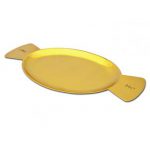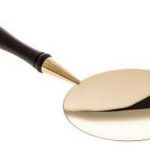QUAERITUR:
Greetings in Christ. I hope this finds you well.
A good, holy, traditional priest in my home diocese has recently claimed in conversation that the Communion-plate is in fact a sacred vessel, hence why they have handles–the servers are not to touch the blessed, plate portion itself.
However this does not fit with my time as a server at ___. There we had plates which had no handles, but small lips on two opposite sides which we simply thumbed to hold the plates. Those Fathers are also very good, holy, and traditional–and if those plates had been sacred, I certainly think they would have told me about it.
I have looked into this myself, but I cannot find any clarity beyond which documents state the plates should be used. Do you know the answer, here?
 The sacred vessels are any vessels that hold sacred things, things that have been consecrated. For example, the chalice and its paten hold the Eucharist. Hence, they are sacred vessels. They receive a special consecration. The monstrance, the ciborium, the pyx, the lunette. These, too, are sacred vessels. So rare as to hardly merit mention are the fistula and papal asterisk. A tabernacle is a sacred vessel, too, as would have been the archaic Eucharistic dove. Vessels that hold consecrated oils are sacred. The bucket for Holy Water is a little ambiguous, since Holy Water is only blessed. And we are encouraged to touch Holy Water with our hands.
The sacred vessels are any vessels that hold sacred things, things that have been consecrated. For example, the chalice and its paten hold the Eucharist. Hence, they are sacred vessels. They receive a special consecration. The monstrance, the ciborium, the pyx, the lunette. These, too, are sacred vessels. So rare as to hardly merit mention are the fistula and papal asterisk. A tabernacle is a sacred vessel, too, as would have been the archaic Eucharistic dove. Vessels that hold consecrated oils are sacred. The bucket for Holy Water is a little ambiguous, since Holy Water is only blessed. And we are encouraged to touch Holy Water with our hands.
However, the Communion paten or plate, which substitutes for the paten on the chalice, or a housling cloth, is intended to “hold the Eucharist”, should it fall. They are gilded. They are concave, like the chalice paten. If particles of the Host drop onto the paten, handle or not, they are born along. If the chalice’s paten is sacred, for it holds the Eucharist, then why not the Communion paten which does the same. The chalice’s paten and the Communion paten are designed for this purpose. They actually do function the way they are designed. A smaller amount of the sacred species is still just as much the Presence of Christ as a larger amount.
I come down on the side of the Communion plate or paten being a sacred vessel. They should be gilded and clean, just like the chalice paten. The handle eliminates a need for gloves, for those who are careful about touching sacred vessels with hands that haven’t been anointed. No handle, then it is better to use gloves when handling it.
I hope this helps.



































In pre-Vatican II practice, the server patens were typically not consecrated- just as the housing cloths were typically blessed as sacred linens. Both could theoretically “hold the Eucharist”- but were never regarded as sacred vessels with the prohibition of non-tonsurati touching them.
The communion paten is one of those things that’s perceived as traditional, but isn’t much more than 100 years old. Many decried it as an abuse in the late 1800’s until SRC said it may be “tolerated, but not recommended.” Its immediate predecessor was the “communion card” that looked like a pall- which was technically a cloth in accord with rubrics that were gone by 1962.
How does it work then, even the handles patens, when the servers receive communion kneeling and pass it to the person beside them and hold it under their chin? Gloves seem a bit impractical.
This article provides some historical and legal background:
http://blog.adw.org/2011/11/how-something-we-consider-solidly-traditional-was-once-thought-as-strangely-progressive-barely-to-be-tolerated-a-brief-study-of-the-communion-chin-paten/
@APX- gloves would not be appropriate at all. In fact, when the Holy See mandated use of the communion paten in 1929, it was presupposed that communicants would pass the plate to each other- similar to how servers customarily do so on the predella. Vide 1929 AAS pg. 638, no. 5
Mr. WmHesch and Mr. Mcferran’s posts reflect my understanding.
In the Dominican Rite, the ministers and friars receive(d) on the altar steps using a communion cloth (and then in the solemn Mass receive unconsecrated wine from a chalice—which they obviously touch—as a mouth ablution). In the pre-19th-century period, there was no people’s communion at our Masses, but even the lay brothers received at the altar steps and received the unconsecrated wine.
When we were charged with parishes in the 1800s, it seems that we conformed to whatever was “Roman” practice to avoid “admiratio.” It is interesting, however, that at private Masses, where the host(s) are carried for the brothers’ Communion on the paten, the server puts the pall under the recipient’s chin—private Mass chapels never had “communion plates.” This reflects the practice mentioned by Mr. WmHesch.
For what is is worth, when I entered the Order in 1977, the practice at the house of studies here in Oakland was the two-handled plate passed from one communicant to the next—and that is still the practice for the laity at the Carmelite monastery where I regularly celebrate (both forms). And no gloves (obviously) were and are used.
I am inclined to think that the communion plate is not a “sacred vessel” in the same sense as the chalice. And, in the middle ages, I don’t even think the paten was considered “sacred” or was consecrated. After all, in that period (and in the solemn Dominican Rite Mass today), the consecrated Host was/is never placed on it. [In the Roman Rite it was/is and the paten is consecrated.]
There is a distinction between a chalice and paten, which are consecrated only by a bishop or other person with the faculty to do so (see Canon 1169, CCL), and a ciborium, pyx or lunette, which are only blessed in accord with the formula in the Roman Ritual. see Fortescue, The Ceremonies of the Roman Rite Described, p.38, and the monstrance, for which neither consecration nor blessing is prescribed, although the latter is often performed, see Fortescue op. cit. p.38, and the communion plate or paten for which “(n)o direction has been given for the blessing … nor has any form of blessing been issued”. J. B. O’Connell, The Celebration of Mass, p.160. I believe that Father’s reference to the use of gloves in the handling of certain sacred vessels was in respect to handling outside of Mass. The wearing of gloves by servers during Mass would not be acceptable. see Collins, The Roman Catholic Ceremonial, v. I, p.79.
Oh, to be clear, I should have made explicit that the carrying of the Host on the paten to communicate friars at a Private Mass is a post-1800 phenomenon. In the pre-modern period the unordained received Communion only at the 15 or so general Communions a year. And these would have been at a Solemn Mass.
Gloves are primarily to avoid soiling the metal which often takes fingerprints, but not to facilitate the touching of sacred vessels. Clerics and those who have charge of the vessels are permitted to touch even consecrated vessels. Traditionally, even Sister Sacristan would handle the sacred vessels with her bare hands because this was her duty. My practice therefore is that if someone must handle these as part of their role, they should simply handle them with clean hands. If there is no need to touch them, they ought not. Certainly during the liturgy, a server should never wear gloves as this is a Pontifical privilege.
If gloves are going to be used, then they should be plain white cotton gloves and used by the servers not merely so they can touch consecrated things, but whenever they are handling items in the Sacristy which could become easily soiled. This would include vestments, brassware. Using a cotton cloth to carry something which you’re not supposed to be touching seems to me mere formalism.
As with other items used in the liturgy but for which there is no specific blessing, I bless Communion plates with the ad omnia blessing. They are not mean to hold Our Lord, as with a pyx, but to be a more fitting surface on which particles could be collected if they fall. Therefore, I might call it a sacred vessel, due to its use, but not because it is blessed or consecrated as such.
The plate also does not replace the housling cloth, which even after the Communion plate was introduced and mandated in 1929, was still required by the rubrics of the Missal and the SRC.
@mcferran
Msgr. Pope, author of that blog page you linked, is a great guy. He leads a monthly Saturday-morning prayer witness at the humongous Planned Parenthood abortion clinic in Northeast Washington, DC. He’s great: he shows up in his cassock and surplice, with a huge rosary with jewel-like beads and several prayerbooks. During the vigil he circumambulates the facility sprinkling it with holy water and more or less exorcising it. (The alleyways around the Planned Parenthood fortress are actually public streets, so there’s nothing PP can do.) The whole show freaks out the eight or so “escorts” wearing orange “pro-choice” tunics whose job it is to whisk the abortion-seeking women into the clinic before they can change their minds. Msgr. Pope is da bomb.
The Mass paten does appear to have been consecrated in the ‘Middle Ages’. see Guilielmus Durandus, Rationale Divinorum Officiorum, Book I, Chapter 8, Par.24:
24. Further the paten is consecrated and anointed for the administration of the body of Christ, who willed to be sacrificed on the altar of the cross for the salvation of all men. Almighty God also did order the flour to be brought to His Altar scattered on golden and silver patens. The chalice is also consecrated and anointed, that by the grace of the Holy Ghost it may be made a new sepulcher of the body and blood of Christ, and then He, Himself may deign to make it overflow with his virtue, as He made the cup of Melchizedech, His servant, to flow over. ( Late 13th Century; I briefly scanned Amylar – mid 9th Century – but found no reference to consecration of either chalice or paten. Perhaps this is due to the evolution of the use of the paten by the 11th Century – see Jungmann, , Mass of the Roman Rite, vol. II, Part 3, Section4, The Fraction).